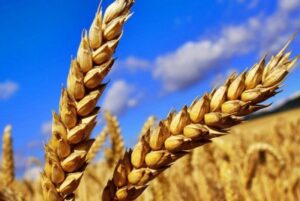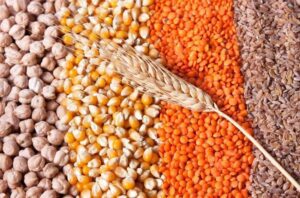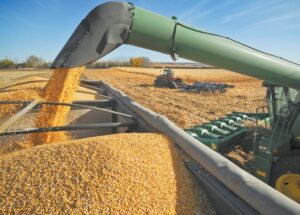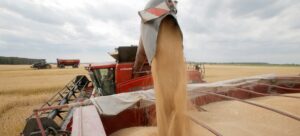
In its August report, the US Department of Agriculture (USDA) increased the forecast for the harvest of Ukrainian corn in 2022/2023 marketing year (MY, July-June) compared to July by 5 million tons – up to 30 million tons from 25 million tons, and its export estimate has been raised by 3.5 million tons to 12.5 million tons from 9 million tons.
According to a report on the website of the US Department of Agriculture, the estimate of domestic corn consumption in Ukraine has been increased by 1 million tons – from 9.5 million tons to 10.5 million tons.
In the new forecast, the agency also increased the forecast for wheat exports from Ukraine in 2022/2023 MY by 1 million tons – up to 11 million tons from 10 million tons, while the assessment of its harvest remained at the same level – 19.5 million tons. At the same time, the forecast for its domestic consumption in Ukraine was also left at the same level of 10.2 million tons.
In addition, the forecast for carry-over stocks of wheat at the end of the current marketing year has been reduced – from 5.24 million tons to 4.24 million tons compared to 5.84 million tons at its beginning.
According to the report, in general, the forecast for the feed grain harvest in Ukraine for 2022/23 MY was increased by 5.7 million tons – up to 37.46 million tons from 31.76 million tons, and its export – by 3.5 million tons, up to 14 .33 million tons from 10.83 million tons.
As reported, since the beginning of MY 2022/2023, Ukraine has exported 2.21 million tons of grain and leguminous crops, which is 2.1 times less than in the previous MY. The country supplied to foreign markets 1.45 million tons of corn (26.1% more than in 2021/2022 MY), 562 thousand tons of wheat (3.2 times less), 192 thousand tons of barley (8.4 times less) and 5.1 thousand tons of flour (3.2 times less).

The forecast for the harvest of grain and oilseeds in Ukraine this season has been improved by approximately 5-7 million tons – up to 65-67 million tons from 60 million tons, according to the website of the government portal on Wednesday.
It is specified that the increase in the harvest forecast was announced by the Minister of Agrarian Policy and Food Mykola Solsky during a conference call between Prime Minister Denys Shmyhal and the heads of regions.
In turn, the Prime Minister noted that in the context of the Russian military invasion in Ukraine, 12 million tons of new crop grain have already been harvested from a total area of 3.5 million hectares.
Shmyhal also announced the emergence of additional opportunities for grain exports due to the unblocking of the Odessa seaport under the Istanbul Agreement on the export of agricultural products from Ukraine, concluded on July 22 under the auspices of the UN.
“In total, in June we exported 3.2 million tons out of 5 million tons (pre-war monthly volumes – IF-U) that were required. Exports are gradually growing both by rail, by road, and through the Danube ports. Sea ports will significantly expand these opportunities and farmers will receive new opportunities for the sale of products. The state is doing everything necessary for this,” the Prime Minister’s government portal quotes.
Shmygal also noted the recently introduced grant program for the development of horticulture, greenhouses, the development of processing and micro-enterprises, under which over 5,000 applications have already been submitted and processed, and this week the first applicants will receive state support.
As reported, the US Department of Agriculture in the July report predicts the harvest of Ukrainian wheat in the 2022/2023 marketing year (MY, July-June) at the level of 19.5 million tons, its export – 10 million tons, domestic consumption within the country – 10.2 million tons . The corn harvest is estimated at 25 million tons, export – 9 million tons, domestic consumption – 10.7 million tons.
In early July, the Ukrainian Grain Association (UGA) increased the forecast for the harvest of grains and oilseeds in Ukraine in 2022 by 4.4% compared to the May forecast, to 69.4 million tons from 66.5 million tons.
According to her forecasts, in 2022 the wheat harvest is expected at the level of 20.8 million tons (+8.3% to the organization’s May forecast); 27.3 million tons of corn (+4.6%); 6.6 million tons of barley (forecast kept); 9 million tons of sunflower (forecast kept); 2.2 million tons of soybeans (+4.7%); 1.5 million tons of rapeseed (+13.3%).

Ukraine plans to harvest up to 20 million tons of wheat, which is five times more than domestic demand, Prime Minister Denys Shmyhal said.
“Yesterday, the first ship with Ukrainian food left the port of Odessa… Firstly, this makes it possible to increase foreign exchange earnings and business income. Not only in the agricultural sector, which employs hundreds of thousands of people, but also in related industries. The second aspect: Ukraine remains important player in the global food market,” he said at a government meeting on Tuesday.
The prime minister stressed that the unblocking of exports is also directly related to the new crop, which is now being harvested by Ukrainian farmers.
“As of the end of July, about 12 million tons have already been harvested. At the same time, we expect to harvest up to 20 million tons of wheat alone, which is five times more than domestic demand. Therefore, it is important for us to help farmers preserve and sell the new crop,” Shmyhal summed up.

Farmers of Odesa region had already harvested almost 2 million tonnes of grain, Serhiy Bratchuk, spokesman for Odesa regional military administration, said.
“We have one more front, we should not forget about it, and it is also one of the main ones – this is the agrarian front. Today, our grain growers have already harvested almost 2 million tonnes [of grain]. The northern parts of Odesa region have joined the harvest. We understand that if there is grain [and there will be!], there is flour. And Odesa region and other regions of our state, and, accordingly, entire Ukraine will have this resource,” he said at a briefing at the Ukraine Media Center on Monday.
At the same time, Bratchuk is convinced that the grain reserves in Odesa region will be sufficient for Ukraine to be able to export it to other countries.

The U.S. Department of Agriculture (USDA) in its report for June published on Friday increased the forecast for Ukrainian corn crop for trade year (TY) 2022/23 by 5 million tonnes compared to the forecast a month ago, to 25 million tonnes, while keeping the export estimate at the level of 9 million tonnes.
U.S. experts increased the forecast for carryovers for 2022/23 TY by 4 million tonnes, to 12.07 million tonnes compared to 6.77 million tonnes for 2021/22 TY.
In addition, USDA raised the estimate of domestic consumption in 2022/23 TY by 1.5 million tonnes, to 10.7 million tonnes.
According to the report, in general, the forecast for the feed grain harvest in Ukraine for 2022/23 TY has been increased by 5.2 million tonnes, to 31.76 million tonnes, although at the same time, the export estimate has been reduced by 0.2 million tonnes, to 10.83 million tonnes.
U.S. experts have increased the forecast of feed grain carryovers following the results of 2022/23 TY by 3.9 million tonnes, to 13.06 million tonnes compared to 7.77 million tonnes at its beginning.
In addition, USDA raised the estimate of domestic consumption of feed grains in 2022/23 TY by 1.5 million tonnes, to 15.65 million tonnes.
The U.S. Department of Agriculture recalled that in 2020/21 TY, the wheat harvest in Ukraine amounted to 25.42 million tonnes, and exports reached 16.85 million tonnes. According to its estimates, in 2021/22 TY, with a crop that has grown to 33.01 million tonnes, exports will increase to 19 million tonnes, and carryovers – from 1.51 to 5.61 million tonnes. In addition, U.S. experts expect domestic wheat consumption in Ukraine to grow to 10 million tonnes in 2021/22 TY from 8.7 million tonnes in the previous TY due to livestock.
As for corn, according to the report, in the past 2020/21 TY, its harvest in Ukraine was 30.3 million tonnes, and exports – 23.86 million tonnes. According to USDA estimates, in this ending trade year, with a corn crop that has grown to 42.13 million tonnes, its exports will decrease to 23 million tonnes, and carryovers will jump from 0.83 to 6.77 million tonnes. In addition, U.S. experts expect domestic corn consumption in Ukraine to grow to 13.2 million tonnes in 2021/22 TY from 7.1 million tonnes in the previous TY, also due to livestock.
In general, the feed grain harvest in Ukraine in 2020/21 TY, according to the U.S. Department of Agriculture, was 39.59 million tonnes, and exports were 28.15 million tonnes. According to USDA estimates, in this ending TY, with a coarse grain harvest that has grown to 53.51 million tonnes, it will increase only to 29.06 million tonnes, and carryovers will jump from 1.65 to 7.77 million tonnes. In addition, the experts expect in 2021/22 TY an increase in domestic consumption of coarse grains in Ukraine to 18.37 million tonnes from 12.41 million tonnes in the previous TY, also due to livestock.

Analysts at Alfa-Bank Ukraine expect a reduction in the grain harvest in 2022 to 56 million tons, which will be the lowest figure in the last 10 years and will mean a decrease of 34% to a record figure for 2021.
“Even this historically small harvest will provide a significant resource of grain for export. Now available transport channels do not make it possible to ship such volumes of marketable products abroad,” commented the head of the analytical department Alexei Blinov in the bank’s report.
It is indicated that the assessment of the future harvest is based on calculations of the sown area in the zone of occupation or active hostilities, as well as the current dynamics of the sown area in the territories controlled by Ukraine. Analysts at Alfa-Bank Ukraine also expect some reduction in yields due to lack of fertilizers and plant protection products.
“The key to Ukraine’s agricultural exports, and this is the food security of the world, should be the lifting of the blockade of Ukrainian seaports,” Blinov stressed.